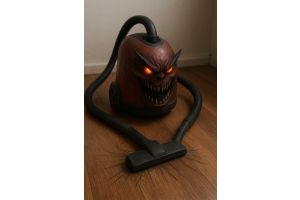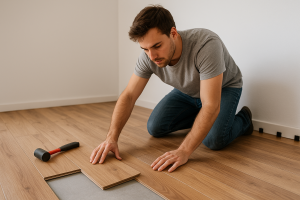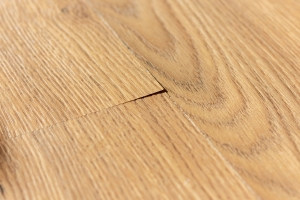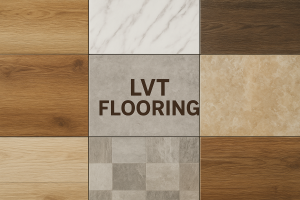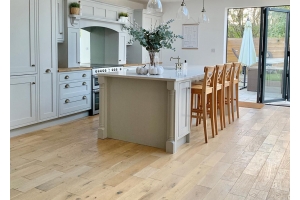
Buying a new wood floor can be tough. Choosing your preferred style, within your budget, is often only half of the battle. Nowadays, there’s a lot of jargon that comes with the process of buying new flooring.
So we’ve decided to do a little jargon-busting. Here’s our A-Z glossary (well, A-W – we tried with X, Y and Z, we really did) on flooring terms that sometimes need a little explaining.
Jump to:
A B C D E F G H I J K L M N O P Q R S T U V W
_
A
Abrasion Class (AC Rating)
Most commonly referred to as an AC rating, abrasion class is a method of rating laminate flooring based on its durability. Ranging from AC1 to AC5, the higher the number the stronger the laminate.
Acclimatisation
This is where you allow new wood flooring to adapt to the room you’ll be laying it in. By leaving wood to acclimatise, your new floor becomes used to its new environment; namely temperature in addition to moisture levels.
Adhesive
Another word for glue, adhesive is a chemical compound that bonds planks to one another, in addition to attaching wood flooring to its subfloor.
_
B
Beading
Used to cover up expansion gaps when fitting wood flooring, most commonly laminate. Is also referred to as scotia.
Bevelled
This is where the edge of the wooden boards create a v-shaped groove between planks once fitted.
Bowing
A form of damage to wood flooring. Rather than a wood plank having a flat face, it’s curved inwards to create an uneven surface.
Brushed
Brushed wood flooring is where a subtle texture has been added to the floor. This is done using wire brushes, which pulls away softer wood on the surface to leave a harder, more textured wooden plank.
Buckling
An extreme reaction of wood flooring to moisture. Boards pull up from the floor, sometimes by several inches, due to excessive water damage.
_
C
Chevron
Chevron is a pattern that’s most commonly used for parquet flooring. Boards are laid together to form a true point, forming a number of ‘V’ patterned lines. Once the whole floor is fitted, it creates a beautiful and uniformed zig-zag.
Click Flooring
A modern fitting mechanism often seen on laminate flooring. Created for easy DIY fitting, two boards fit and ‘click’ together. This ensures each board is securely joined together whilst speeding up the installation process.
Crowning
Distortion of wood flooring, where the centre of a wooden floorboard raises up, so it’s higher than the edges, which makes for an uneven floor.
Cupping
The opposite of crowning, where the edges raise above the centre of a board. This gives the wood a concave appearance.
_
D
Damp Proof Membrane (DPM)
DPM is fitted between wood flooring and its subfloor to protect from moisture damage. It’s especially used with concrete subfloors which can hold large levels of moisture. Many underlays come with built-in DPM.
Distressed
Often used to give wood flooring a slightly worn look. The process of creating distressed wood flooring often consists of creating subtle superficial damage to the flooring. These blemishes are only subtle, and don’t affect the longevity of the boards.
Durability
Another word for strength. The durability of a wooden floor is how it endures particular situations without notable damage.
_
E
End Profile
An end profile is used when a section on laminate flooring meets a wall or skirting board. They are colour-matched to create a similar look between your flooring and profile finishing.
Engineered Wood
Engineered Wood is a form of wood flooring made up from crossed layers of plywood or high density fibreboard (HDF). This is then covered by a top layer of solid wood, often between 3-7mm thick.
Expansion Gap
This is a gap that’s present on the outside of a room fitted with wood floor. Wood is known to expand and grow after it’s been laid. An expansion gap ensures there is enough space to prevent damage to the flooring.
_
F
Feature Strips
Sometimes referred to as design or grouting strips. Feature strips are used with luxury vinyl tile (LVT) flooring in order to imitate the appearance of grout that would be used in between real tiles.
Finish
Describes the final coating on the wood. Often consists of a wood floor finishing oil to give it a shine or matt finish and coloured tint.
Floating Floor
A floating floor is one of the three main installation methods for wood flooring. Rather than being glued or nailed, the floor is not attached to the subfloor when fitted.
_
G
Gloss
A finish given to wood flooring to make the surface shine.
Glue Down Floor
As the name suggests, a glue-down installation uses adhesive to bond wood flooring to the subfloor. Most commonly used with solid wood flooring.
Grains
Naturally-occurring lines in wood that create various patterns. Laminate and LVT flooring can have them artificially created to mimic an authentic wood look and feel.
_
H
Hand Scraped
A technique used to give wood flooring a distressed look. Many believe it adds character to the wood, making it look slightly worn and vintage.
Herringbone
One of the most popular trends in wood flooring, herringbone flooring uses simple rectangular blocks fitted in a zig-zag pattern. As the name suggests, the final pattern resembles the structure of fish bones.
High Density Fibreboard (HDF)
Often referred to as hardboard, HDF is made of wood fibres that are compressed to create a solid wood core. It’s used primarily in engineered wood and laminate flooring products.
Humidity
The moisture levels in the air. The humidity of a room should be checked before fitting wood flooring. Too much water vapour (which causes high moisture levels) can cause damage to wood over the long-term.
_
I
Insulation
Often built into a room’s subfloor, insulation improves the sound-proofing and warmth of a room.
_
J
Joist
A wooden beam that supports either floors or ceilings. Numerous joints create a subfloor suitable for installing on top of.
_
K
Kite
Another word for a turn in a staircase, often found at the top or bottom of stairs.
Knots
Small, round imperfections that are ingrained into wood planks. Caused by wood branches growing out from trees before falling off.
_
L
Lacquered
Used as a varnish for wood flooring, lacquer is a resin that covers the top layer of each board. A lacquered wood floor has a glossy finish, making them easier to maintain and clean.
Laminate Flooring
A wood flooring with a core made from HDF. Laminate’s top layer is a printed image to give the appearance of wood, which is then given a scratch and moisture-resistant, antibacterial coating.
Luxury Vinyl Tile
A vinyl tile that’s made primarily from PVC vinyl. Luxury vinyl tiles are topped with a particularly realistic printed image, made to mimic a range of styles from wood to stone.
_
M
Maintenance
Ways of caring for and looking after your wood flooring in order to increase its longevity.
Matt
Applying a matt finish to wood flooring makes the surface more natural and non-reflective. A Matt finish highlight’s a wood’s natural colours, and show scratches less than a gloss finish.
Moisture Content
This can refer to either a room’s subfloor or wood flooring itself, and describes the level of moisture that can be found within either. Often given as a percentage.
Multi-Use Profile
Multi-use profiles are a dynamic accessory which allows you to bridge the gap between different types of flooring. They work for floors of different heights and well as similar heights, hence the multi-use name.
_
N
Nosing
An accessory that’s applied to corners, most commonly on stairs covered with wood flooring. Effectively hides where wood planks join, in addition to covering corners for a smoother finish.
_
O
Oiled
Wood flooring that’s been oiled has additional surface protection due to an extra layer over the surface. Oil is also used to give colour to unfinished wood flooring.
_
P
Parquet Flooring
Often laid in either a herringbone or chevron pattern, although there are many more popular styles of parquet. Generally made from either solid or engineered wood.
Plywood
A strong wooden board, consisting of multiple layers to give additional durability. Often laid is opposing directions for added strength, and then glued together for stability.
Pull Bar
Found in most wood floor fitting kits, a pull bar is used to pull together wood planks in order to ensure a secure fit.
PVC Vinyl
PVC, or polyvinyl chloride, is a form of plastic vinyl that makes up luxury vinyl tiles.
_
Q
Quantity
The number of packs you require of your chosen flooring. In addition, the quantity you require is dependent on pack size, which varies from product to product.
_
R
Ramp Profile
Ramp profiles are used when joining wood flooring to areas with different floor heights. Most popular when joining a room with wood flooring onto one with carpet.
Rustic
Wood flooring that looks naturally dated and therefore often a little rough. Paired with colour variations and prominent grains and knots, rustic wood is a popular choice for those looking for a particularly unique aesthetic for their interior design.
_
S
Sanding
Sanding is a process that removes wood flooring’s top layer, which creates a smooth surface ready for finishing. Solid and engineered woods can be sanded and then re-finished if damaged or worn.
Scotia
Wood accessory that covers expansion gaps around the perimeter of a floor. Also referred to as beading.
Screed
A compound that often consists of sand mixed together with cement. Used to level a concrete subfloor before fitting a wood flooring.
Scribing
Scribing describes the process of marking cut lines wooden planks, to help them fit around awkward shapes such as alcoves or protruding walls.
Secret Nailing/Screwing
A method of fitting flooring in place with either screws or nails. Nails or screws are driven into the tongue of boards to attach it to the subfloor, before being covered by the adjacent plank’s groove.
Skirting
Skirting refers to the wooden boards that cover the bottom of walls around the room. It’s serves to disguise the join between the wall surface and the floor, but is mostly decorative.
Solid Wood Flooring
The name given to wood flooring made from one piece of wood. Each board explicitly displays the wood’s natural qualities.
Spacers
Spacers create an expansion gap when fitting wood flooring. The spacers are placed in between the floor and wall during installation, creating a 7-10mm gap which allows for expansion.
Species
Refers to the tree that the flooring is made from, e.g. oak or maple. In engineered wood, this is the tree that the solid top layer has been cut from.
Staining
The process of applying oil to an unfinished wood floor. This stains the wood accordingly to match a home or commercial property’s existing colour scheme.
Subfloor
The surface on top of which the wood flooring is fitted. Most subfloors are either wooden or concrete.
_
T
T-Profile
A T-profile works similarly to ramp profiles, by determining room boundaries. Whereas a ramp profile is used when the heights are uneven, a T-profile is used for floors that are a similar height.
Tapping Block
A tapping block is used to prevent damage when fitting wood or laminate flooring. To ensure a snug fit, boards are gently hammered together. A tapping block is placed in between the hammer and wood, subsequently preventing any dents or cracks occurring.
Threshold
This is the area at the bottom of doorways that separates rooms. Colour-matched profiles ensure a seamless look and feel throughout the flooring.
Tongue and Groove
Tongue and groove is a method of fitting boards together for simple installation. A protruding edge (the tongue) fits into a groove on the adjacent plank. Often found on solid wood flooring, tongue and groove helps with quick and efficient fitting.
_
U
Underfloor Heating (UFH)
Underfloor heating is compatible with various wood flooring types. A water or electric-based system of pipes underneath the floor generate heat from underfoot.
Underlay
Fit underlay before your wood flooring to add an extra layer. It provides comfort and support, as well as protecting wood or the subfloor from damage after prolonged use.
Unfinished
Wood flooring that hasn’t had any oil, lacquer or brushing applied to it. Unfinished wood flooring is therefore a popular choice for people who want to choose their own oil to stain the flooring to their desired colour.
_
V
V-Groove
The groove between planks that have bevelled edges. This therefore helps each plank to be more defined, and is present in most modern wood floors.
Veneer
Found on engineered wood, veneer is a layer of solid wood. The veneer is decorative and adds extra protection to the engineered core.
_
W
Warping
The damage and distortion of wood flooring. Excessive exposure to moisture and fluctuating temperatures are damaging to wood, and can subsequently lead to warping.
Wear Layer
The top surface of an engineered or wood laminate flooring.
Whitewashed
Wood flooring that has been sanded and stained in a white colour before being sealed. Furthermore, this flooring's commonly used to brighten up rooms in areas with low light levels.
Need help with something that isn’t in our glossary? Let us know in the comments and we’ll get back to you! If you'd like to speak to someone instead, you can get in touch with our professionals by calling 03308 088 777, or email [email protected].








